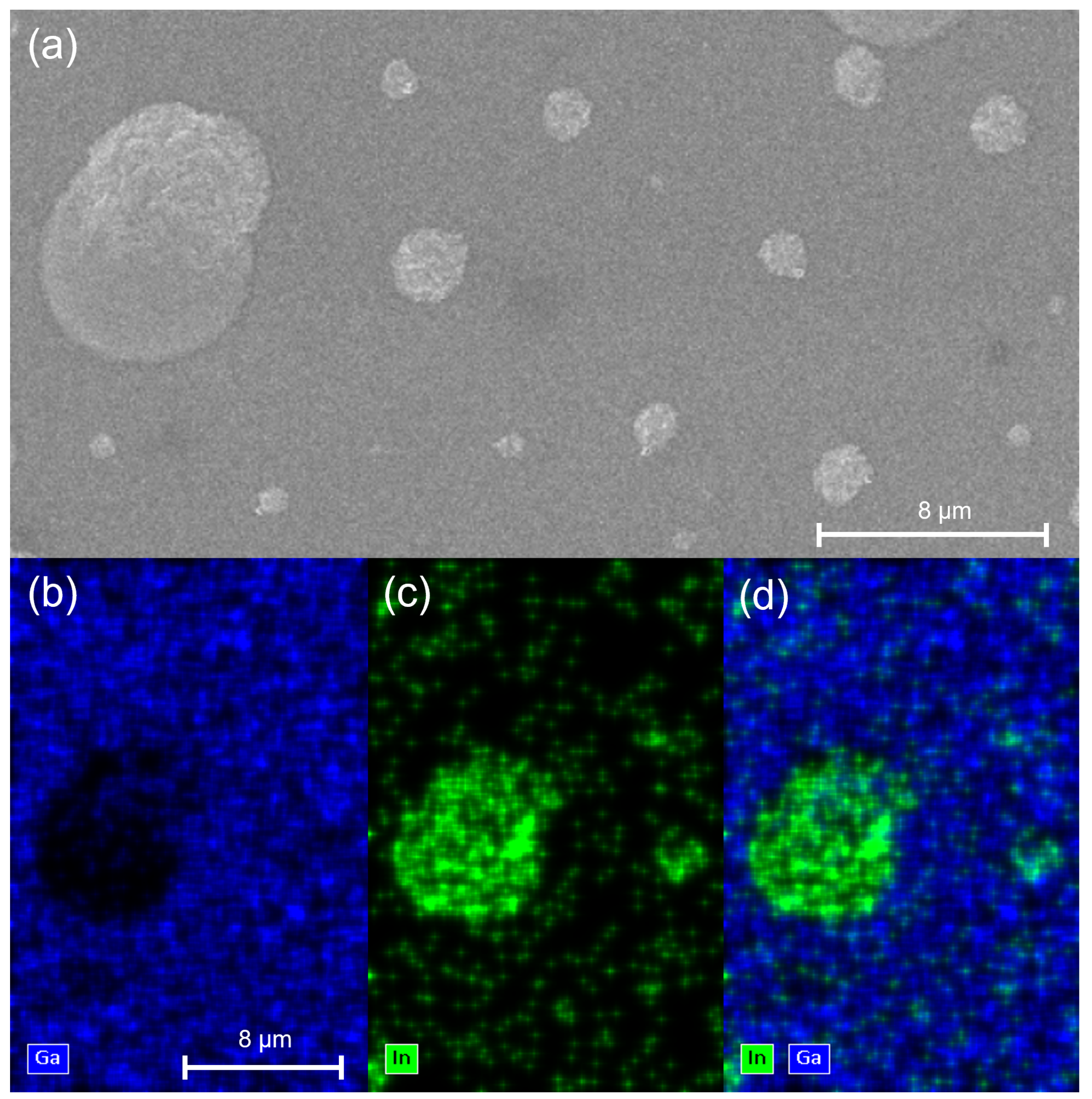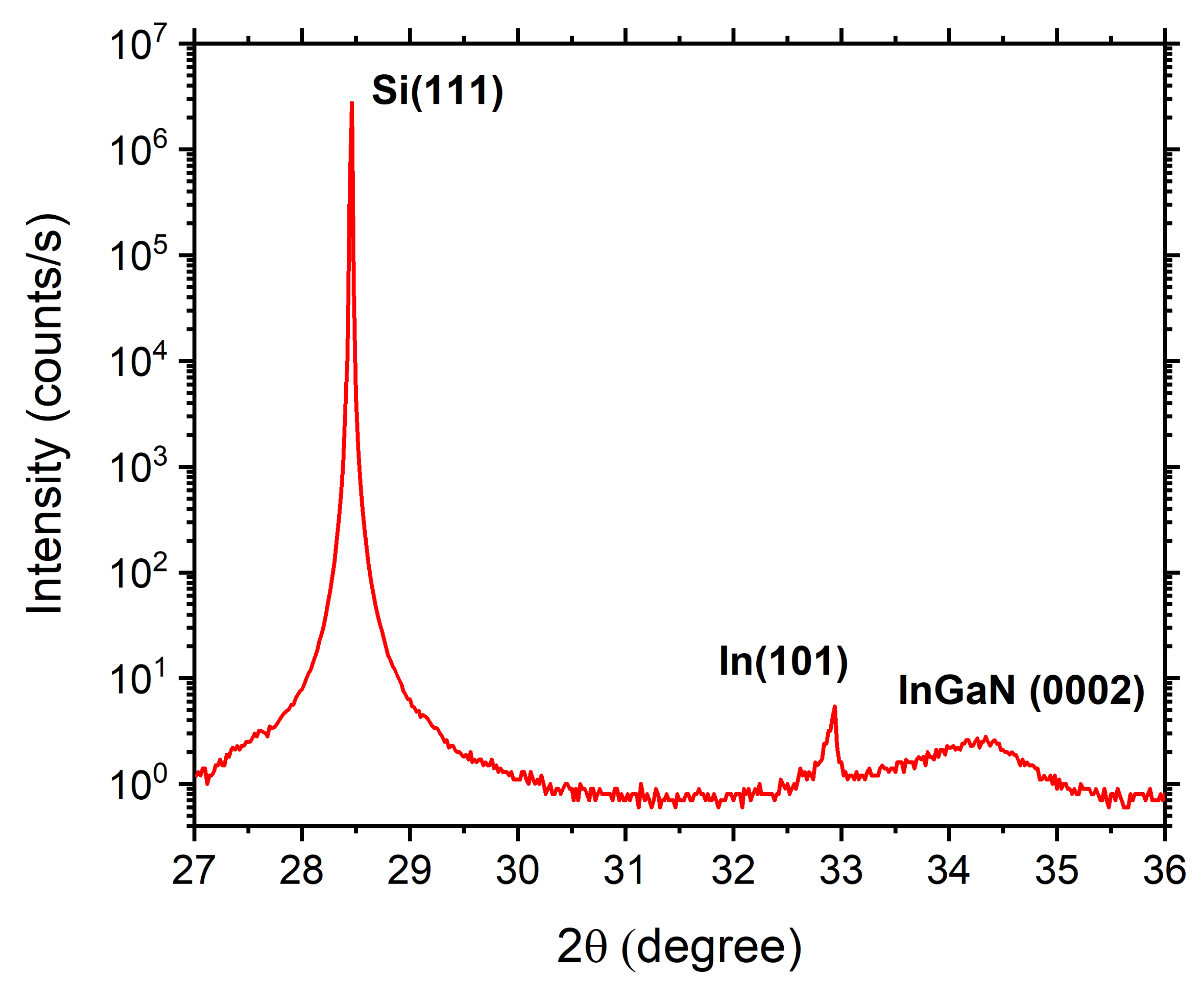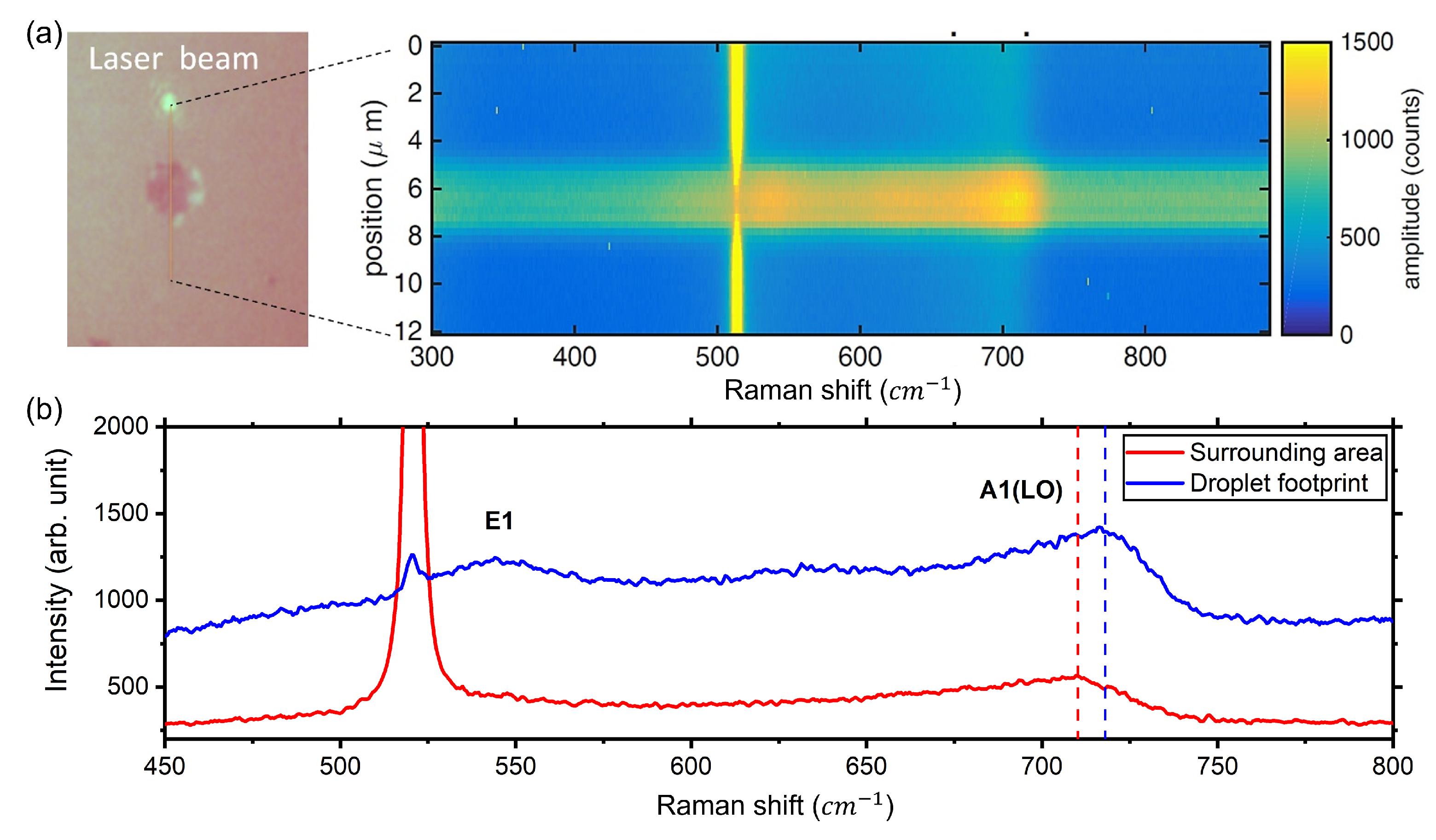Vapour Liquid Solid Growth Effects on InGaN Epilayers Composition Uniformity in Presence of Metal Droplets
Abstract
:1. Introduction
2. Materials and Methods
3. Results
4. Discussion
5. Conclusions
Author Contributions
Funding
Data Availability Statement
Acknowledgments
Conflicts of Interest
References
- Yam, F.K.; Hassan, Z. InGaN: An overview of the growth kinetics, physical properties and emission mechanisms. Superlattices Microstruct. 2008, 43, 1–23. [Google Scholar] [CrossRef]
- Hsu, L.; Walukiewicz, W. Modeling of InGaN/Si tandem solar cells. J. Appl. Phys. 2008, 104, 024507. [Google Scholar] [CrossRef] [Green Version]
- Tchernycheva, M.; Messanvi, A.; De Luna Bugallo, A.; Jacopin, G.; Lavenus, P.; Rigutti, L.; Zhang, H.; Halioua, Y.; Julien, F.H.; Eymery, J.; et al. Integrated photonic platform based on InGaN/GaN nanowire emitters and detectors. Nano Lett. 2014, 14, 3515–3520. [Google Scholar] [CrossRef] [PubMed]
- Aseev, P.; Rodriguez, P.E.D.S.; Gómez, V.J.; Alvi, N.U.H.; Mánuel, J.M.; Morales, F.M.; Jiménez, J.J.; García, R.; Senichev, A.; Lienau, C.; et al. Near-infrared emitting In-rich InGaN layers grown directly on Si: Towards the whole composition range. Appl. Phys. Lett. 2015, 106, 072102. [Google Scholar] [CrossRef]
- Alvi, N.H.; Soto Rodriguez, P.E.; Gómez, V.J.; Kumar, P.; Amin, G.; Nur, O.; Willander, M.; Nötzel, R. Highly efficient potentiometric glucose biosensor based on functionalized InN quantum dots. Appl. Phys. Lett. 2012, 101. [Google Scholar] [CrossRef] [Green Version]
- Alvi, N.U.H.; Rodriguez, P.E.; Gómez, V.J.; Kumar, P.; Willander, M.; Nötzel, R. Highly sensitive and fast anion-selective InN quantum dot electrochemical sensors. Appl. Phys. Express 2013, 6, 115201. [Google Scholar] [CrossRef]
- Iliopoulos, E.; Georgakilas, A.; Dimakis, E.; Adikimenakis, A.; Tsagaraki, K.; Androulidaki, M.; Pelekanos, N.T. InGaN(0001) alloys grown in the entire composition range by plasma assisted molecular beam epitaxy. Phys. Status Solidi (A) Appl. Mater. Sci. 2006, 203, 102–105. [Google Scholar] [CrossRef]
- Ho, I.H.; Stringfellow, G.B. Solid phase immiscibility in GaInN. Appl. Phys. Lett. 1996, 69, 2701–2703. [Google Scholar] [CrossRef]
- Wakahara, A.; Tokuda, T.; Dang, X.Z.; Noda, S.; Sasaki, A. Compositional inhomogeneity and immiscibility of a GaInN ternary alloy. Appl. Phys. Lett. 1997, 71, 906–908. [Google Scholar] [CrossRef]
- Doppalapudi, D.; Basu, S.N.; Ludwig, K.F.; Moustakas, T.D. Phase separation and ordering in InGaN alloys grown by molecular beam epitaxy. J. Appl. Phys. 1998, 84, 1389–1395. [Google Scholar] [CrossRef]
- El-Masry, N.A.; Piner, E.L.; Liu, S.X.; Bedair, S.M. Phase separation in InGaN grown by metalorganic chemical vapor deposition. Appl. Phys. Lett. 1998, 72, 40–42. [Google Scholar] [CrossRef]
- Ambacher, O.; Brandt, M.S.; Dimitrov, R.; Metzger, T.; Stutzmann, M.; Fischer, R.A.; Miehr, A.; Bergmaier, A.; Dollinger, G. Thermal stability and desorption of group III nitrides prepared by metal organic chemical vapor deposition. J. Vac. Sci. Technol. Microelectron. Nanometer Struct. 1996, 14, 3532–3542. [Google Scholar] [CrossRef]
- Dimakis, E.; Georgakilas, A.; Androulidaki, M.; Tsagaraki, K.; Kittler, G.; Kalaitzakis, F.; Cengher, D.; Bellet-Amalric, E.; Jalabert, D.; Pelekanos, N.T. Plasma-assisted MBE growth of quaternary InAlGaN quantum well heterostructures with room temperature luminescence. J. Cryst. Growth 2003, 251, 476–480. [Google Scholar] [CrossRef]
- Böttcher, T.; Einfeldt, S.; Kirchner, V.; Figge, S.; Heinke, H.; Hommel, D.; Selke, H.; Ryder, P.L. Incorporation of indium during molecular beam epitaxy of InGaN. Appl. Phys. Lett. 1998, 73, 3232–3234. [Google Scholar] [CrossRef] [Green Version]
- Bord, O.V.; Talalaev, R.A.; Karpov, S.Y.; Makarov, Y.N. Indium incorporation and droplet formation during InGaN molecular beam epitaxy. Phys. Status Solidi (A) Appl. Res. 1999, 176, 297–300. [Google Scholar] [CrossRef]
- Kumar, P.; Rodriguez, P.E.; Gómez, V.J.; Alvi, N.H.; Calleja, E.; Nötzel, R. First demonstration of direct growth of planar high-in-composition InGaN layers on Si. Appl. Phys. Express 2013, 6, 035501. [Google Scholar] [CrossRef]
- Azadmand, M.; Barabani, L.; Bietti, S.; Chrastina, D.; Bonera, E.; Acciarri, M.; Fedorov, A.; Tsukamoto, S.; Nötzel, R.; Sanguinetti, S. Droplet Controlled Growth Dynamics in Molecular Beam Epitaxy of Nitride Semiconductors. Sci. Rep. 2018, 8, 1–8. [Google Scholar] [CrossRef] [Green Version]
- Heying, B.; Averbeck, R.; Chen, L.F.; Haus, E.; Riechert, H.; Speck, J.S. Control of GaN surface morphologies using plasma-assisted molecular beam epitaxy. J. Appl. Phys. 2000, 88, 1855–1860. [Google Scholar] [CrossRef]
- Adelmann, C.; Brault, J.; Jalabert, D.; Gentile, P.; Mariette, H.; Mula, G.; Daudin, B. Dynamically stable gallium surface coverages during plasma-assisted molecular-beam epitaxy of (0001) GaN. J. Appl. Phys. 2002, 91, 9638–9645. [Google Scholar] [CrossRef] [Green Version]
- Tarsa, E.J.; Heying, B.; Wu, X.H.; Fini, P.; DenBaars, S.P.; Speck, J.S. Homoepitaxial growth of GaN under Ga-stable and N-stable conditions by plasma-assisted molecular beam epitaxy. J. Appl. Phys. 1997, 82, 5472–5479. [Google Scholar] [CrossRef]
- Fernández-Garrido, S.; Grandal, J.; Calleja, E.; Sánchez-García, M.A.; López-Romero, D. A growth diagram for plasma-assisted molecular beam epitaxy of GaN nanocolumns on Si(111). J. Appl. Phys. 2009, 106, 1–4. [Google Scholar] [CrossRef]
- Yamaguchi, T.; Uematsu, N.; Araki, T.; Honda, T.; Yoon, E.; Nanishi, Y. Growth of thick InGaN films with entire alloy composition using droplet elimination by radical-beam irradiation. J. Cryst. Growth 2013, 377, 123–126. [Google Scholar] [CrossRef]
- Yamaguchi, T.; Nanishi, Y. Indium droplet elimination by radical beam irradiation for reproducible and high-quality growth of InN by RF molecular beam epitaxy. Appl. Phys. Express 2009, 2, 051001. [Google Scholar] [CrossRef]
- Moseley, M.; Lowder, J.; Billingsley, D.; Doolittle, W.A. Control of surface adatom kinetics for the growth of high-indium content InGaN throughout the miscibility gap. Appl. Phys. Lett. 2010, 97, 70–73. [Google Scholar] [CrossRef]
- Moseley, M.; Gunning, B.; Greenlee, J.; Lowder, J.; Namkoong, G.; Alan Doolittle, W. Observation and control of the surface kinetics of InGaN for the elimination of phase separation. J. Appl. Phys. 2012, 112, 014909. [Google Scholar] [CrossRef]
- Yin, Y.; Sun, H.; Sang, L.; Chen, P.; Zheng, Y.; Dierre, B.; Sumiya, M.; Shi, Y.; Sekiguchi, T. Influence of dislocations on indium diffusion in semi-polar InGaN/GaN heterostructures. AIP Adv. 2015, 5, 057129. [Google Scholar] [CrossRef]
- Fang, H.; Yang, Z.J.; Wang, Y.; Dai, T.; Sang, L.W.; Zhao, L.B.; Yu, T.J.; Zhang, G.Y. Analysis of mass transport mechanism in InGaN epitaxy on ridge shaped selective area growth GaN by metal organic chemical vapor deposition. J. Appl. Phys. 2008, 103, 014908. [Google Scholar] [CrossRef]
- Nakada, Y.; Aksenov, I.; Okumura, H. GaN heteroepitaxial growth on silicon nitride buffer layers formed on Si (111) surfaces by plasma-assisted molecular beam epitaxy. Appl. Phys. Lett. 1998, 73, 827–829. [Google Scholar] [CrossRef]
- Azadmand, M.; Bonera, E.; Chrastina, D.; Bietti, S.; Tsukamoto, S.; Nötzel, R.; Sanguinetti, S. Raman spectroscopy of epitaxial InGaN/Si in the central composition range. Jpn. J. Appl. Phys. 2019, 58. [Google Scholar] [CrossRef]
- Lu, H.; Thothathiri, M.; Wu, Z.; Bhat, I. Study of indium droplets formation on the InxGa1-xN films by single crystal X-ray diffraction. J. Electron. Mater. 1997, 26, 281–284. [Google Scholar] [CrossRef]
- Voorhees, P.W. The Theory of Ostwald Ripening. J. Stat. Phys. 1985, 38, 231–252. [Google Scholar] [CrossRef] [Green Version]
- Grille, H.; Schnittler, C.; Bechstedt, F. Phonons in ternary group-III nitride alloys. Phys. Rev.-Condens. Matter Mater. Phys. 2000, 61, 6091–6105. [Google Scholar] [CrossRef]
- Alexson, D.; Bergman, L.; Nemanich, R.J.; Dutta, M.; Stroscio, M.A.; Parker, C.A.; Bedair, S.M.; El-Masry, N.A.; Adar, F. Ultraviolet Raman study of A1(LO) and E2 phonons in InxGa1-xN alloys. J. Appl. Phys. 2001, 89, 798–800. [Google Scholar] [CrossRef]
- Priante, G.; Glas, F.; Patriarche, G.; Pantzas, K.; Oehler, F.; Harmand, J.C. Sharpening the Interfaces of Axial Heterostructures in Self-Catalyzed AlGaAs Nanowires: Experiment and Theory. Nano Lett. 2016, 16, 1917–1924. [Google Scholar] [CrossRef]
- Namkoong, G.; Trybus, E.; Lee, K.K.; Moseley, M.; Doolittle, W.A.; Look, D.C. Metal modulation epitaxy growth for extremely high hole concentrations above 1019 cm-3 in GaN. Appl. Phys. Lett. 2008, 93, 1–4. [Google Scholar] [CrossRef] [Green Version]
- Clinton, E.A.; Vadiee, E.; Fabien, C.A.; Moseley, M.W.; Gunning, B.P.; Doolittle, W.A.; Fischer, A.M.; Wei, Y.O.; Xie, H.; Ponce, F.A. A review of the synthesis of reduced defect density InxGa1−xN for all indium compositions. Solid-State Electron. 2017, 136, 3–11. [Google Scholar] [CrossRef]



Publisher’s Note: MDPI stays neutral with regard to jurisdictional claims in published maps and institutional affiliations. |
© 2022 by the authors. Licensee MDPI, Basel, Switzerland. This article is an open access article distributed under the terms and conditions of the Creative Commons Attribution (CC BY) license (https://creativecommons.org/licenses/by/4.0/).
Share and Cite
Azadmand, M.; Vichi, S.; Cesura, F.G.; Bietti, S.; Chrastina, D.; Bonera, E.; Vanacore, G.M.; Tsukamoto, S.; Sanguinetti, S. Vapour Liquid Solid Growth Effects on InGaN Epilayers Composition Uniformity in Presence of Metal Droplets. Nanomaterials 2022, 12, 3887. https://doi.org/10.3390/nano12213887
Azadmand M, Vichi S, Cesura FG, Bietti S, Chrastina D, Bonera E, Vanacore GM, Tsukamoto S, Sanguinetti S. Vapour Liquid Solid Growth Effects on InGaN Epilayers Composition Uniformity in Presence of Metal Droplets. Nanomaterials. 2022; 12(21):3887. https://doi.org/10.3390/nano12213887
Chicago/Turabian StyleAzadmand, Mani, Stefano Vichi, Federico Guido Cesura, Sergio Bietti, Daniel Chrastina, Emiliano Bonera, Giovanni Maria Vanacore, Shiro Tsukamoto, and Stefano Sanguinetti. 2022. "Vapour Liquid Solid Growth Effects on InGaN Epilayers Composition Uniformity in Presence of Metal Droplets" Nanomaterials 12, no. 21: 3887. https://doi.org/10.3390/nano12213887






